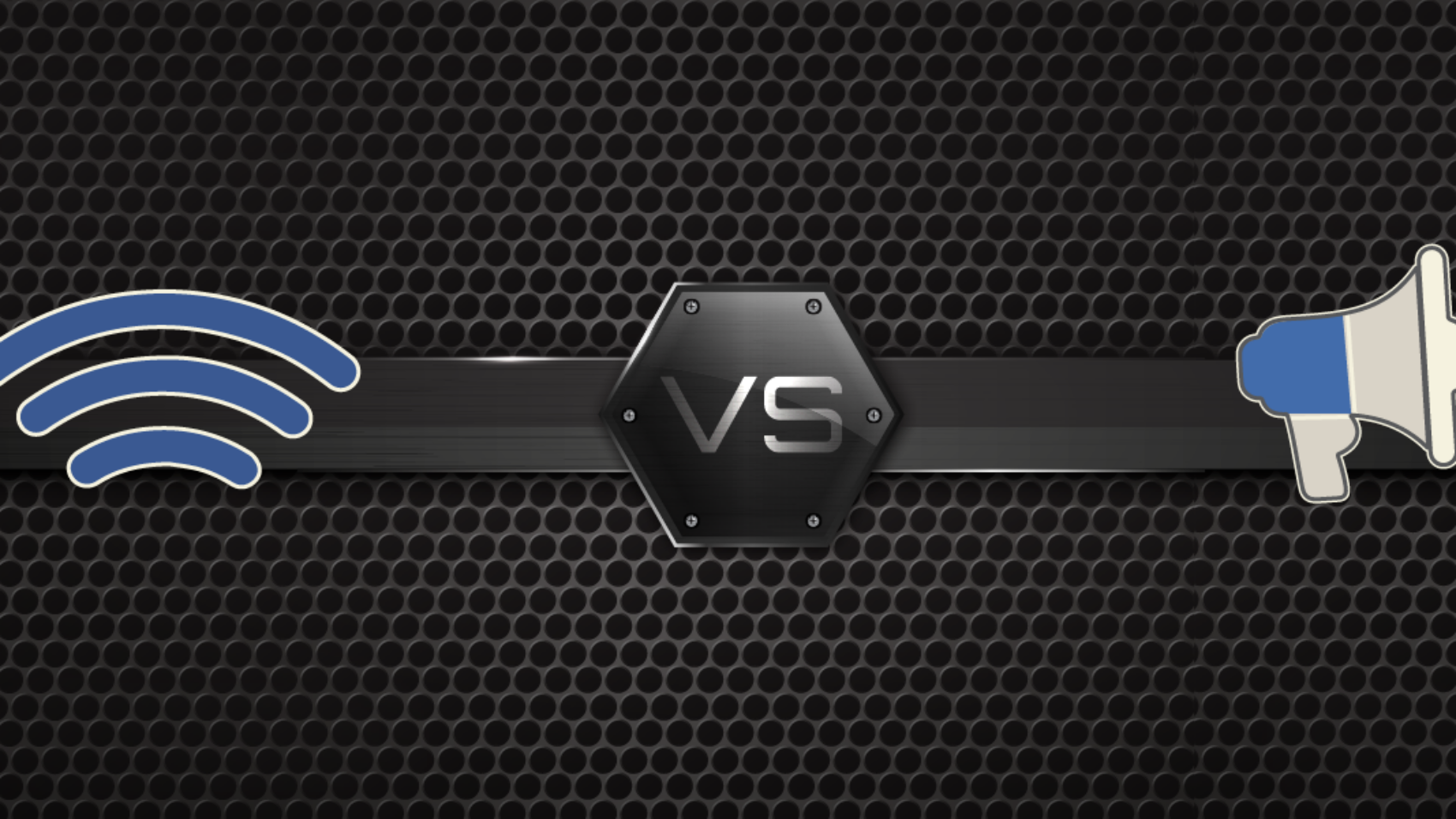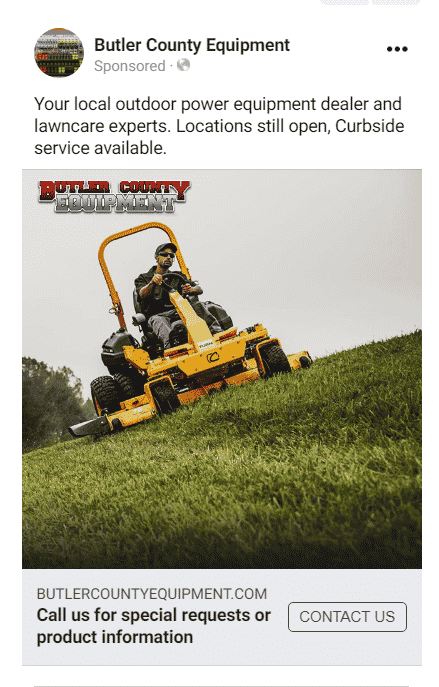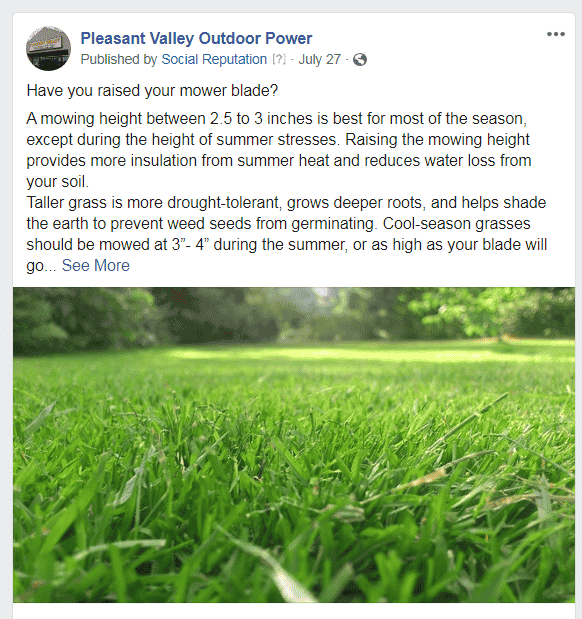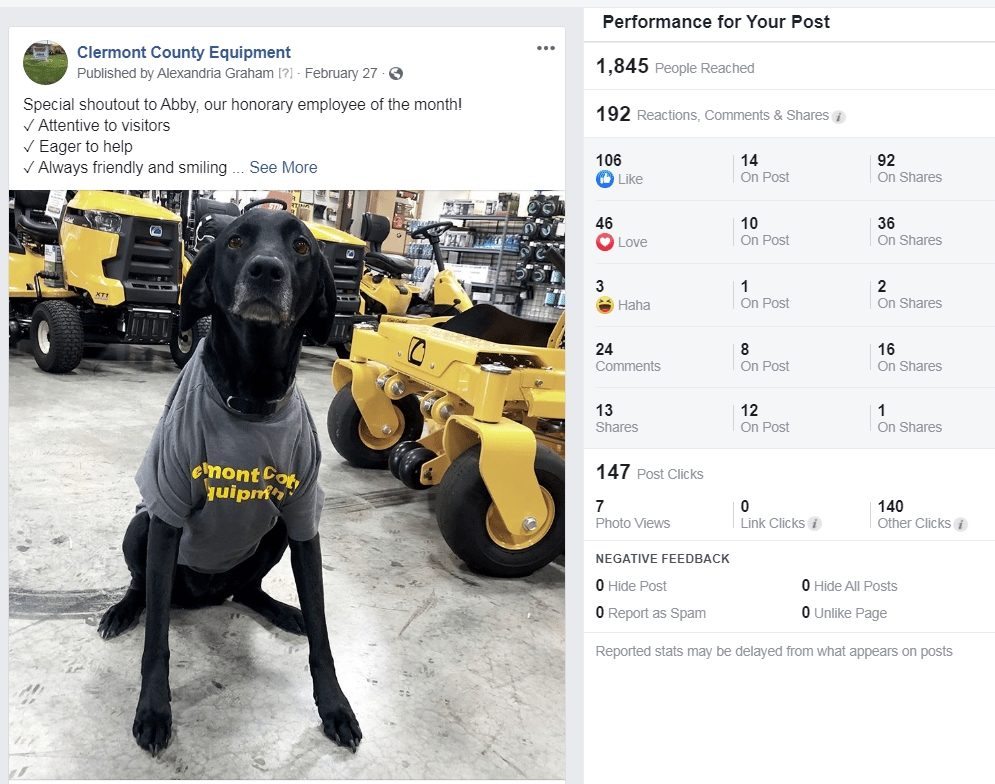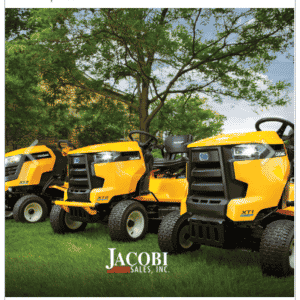If you’re a lawnmower or tractor dealer looking to increase local sales, Facebook ads can be an incredibly powerful tool. With over 2.8 billion monthly active users, Facebook offers a vast audience for businesses to target their ads. However, with so many options and targeting settings available, setting up successful Facebook ad campaigns can be a daunting task. In this post, we’ll cover the different ad objectives and how to choose the right targeting options to set your lawnmower and tractor dealership up for success.
Ad Objectives
Facebook offers several ad objectives, each with its own unique set of goals and targeting options. The right objective for your dealership will depend on your business goals and the specific actions you want users to take when interacting with your ads.
Here are the 6 different ad objectives available on Facebook:
Sales Objective: The Sales objective is ideal for lawnmower and tractor dealerships looking to drive direct sales through their Facebook ad campaigns. With this objective, you can set up conversion tracking to measure how many sales your ads are generating and optimize your campaigns for conversions. You can also use dynamic ads to re-target users who have shown an interest in your products, which can help to increase your sales.
Leads Objective: The Leads objective is designed to help you collect user information, such as email addresses and phone numbers, directly from your Facebook ads. This objective is a great way to build your customer database and generate leads for your lawnmower and tractor dealership. With lead generation ads, users can fill out a form without leaving Facebook, which can help to improve your conversion rates.
Engagement Objective: Engagement ads are designed to increase likes, comments and shares on your Facebook posts. These ads are a great way to increase your dealership’s visibility and build brand awareness. You can use engagement ads to promote your products, share customer reviews and testimonials and showcase your dealership’s values and mission.
Traffic Objective: The Traffic objective is designed to drive traffic to your website or a specific landing page. This objective is ideal for lawnmower and tractor dealerships looking to increase their online presence and drive more traffic to their website. You can use this objective to promote specific products or services, share blog posts and articles and drive traffic to your online store.
Awareness Objective: Awareness ads are designed to increase brand awareness and reach a wider audience. These ads are ideal for lawnmower and tractor dealerships looking to increase their local presence and build brand recognition. With this objective, you can reach a larger audience and increase your dealership’s visibility in your local community.
App Promotion Objective: If you have a mobile app for your dealership, the App Promotion objective is designed to drive app installations and engagement. With this objective, you can promote your app to a specific audience and encourage users to download and engage with your app. You can also use app install ads to re-target users who have previously installed your app but have not engaged with it recently.
Choosing the Right Targeting Options
Once you’ve chosen your ad objective, it’s time to choose the right targeting options to ensure your Facebook ad campaigns are reaching the right audience.
Here are some key targeting options to consider:
Location: When it comes to location targeting, Facebook provides several options that can help you reach users in your local area. By targeting users within a specific radius of your dealership or in a specific zip code, you can ensure that your ads are being seen by potential customers who are likely to be interested in your products and services. This can be particularly effective for lawnmower and tractor dealerships, as many customers may be searching for local options when looking to purchase outdoor equipment.
Age and Gender: Depending on the products and services you offer; age and gender targeting can be an important consideration when setting up your Facebook ad campaigns. For example, if your dealership sells equipment primarily designed for male customers, you may want to target males over a certain age range. However, if you offer products and services that appeal to both genders and a wide range of age groups, it may be more effective to target a broader audience.
Interests: Facebook’s interest targeting can be a powerful tool for lawnmower and tractor dealerships looking to reach potential customers who are interested in outdoor activities, gardening and home improvement. By targeting users who have expressed an interest in these areas, you can ensure that your ads are reaching users who are likely to be interested in your products and services.
Lookalike Audiences: Lookalike audiences allow you to expand your reach beyond your existing customer base by targeting users who share similar interests and behaviors with your current customers. This can be a great way to reach new potential customers who may not have been aware of your dealership previously.
Custom Audiences: Custom audiences allow you to target users who have already interacted with your dealership in some way, such as by visiting your website or engaging with your Facebook page. By targeting these users, you can ensure that your ads are being seen by users who are already familiar with your dealership and may be more likely to make a purchase.
In addition to these targeting options, it’s important to continually test and optimize your ad campaigns to ensure that they are driving the results you need to increase local sales. This may include testing different ad creatives, ad placements, and ad formats to see what works best for your dealership. By continually refining and improving your Facebook ad campaigns, you can maximize the ROI of your advertising efforts and reach more potential customers in your local area.
Why Do the Right Ad Objective & Targeting Options Matter?
Choosing the right ad objective and targeting options is crucial for the success of your Facebook ad campaigns, especially for a local business like a lawnmower and tractor dealership.
Choosing the right ad objective ensures that your ads are optimized for the specific action you want users to take, whether it’s making a purchase, filling out a form, or increasing brand awareness. This helps you achieve your business goals and measure the success of your campaigns more effectively.
Secondly, choosing the right targeting options helps you reach the right audience, which is key for a local business. By targeting users in your area who are interested in your products and services, you can ensure that your ads are reaching the people who are most likely to become customers. This not only helps you increase local sales but also helps you maximize your advertising budget by reducing wasted ad spending.
Additionally, by using advanced targeting options like lookalike audiences and custom audiences, you can reach users who are like your existing customers or who have already shown interest in your dealership. This can be particularly effective for increasing brand awareness and driving conversions.
Choosing the right ad objective and targeting options is essential in achieving your business goals, reaching the right audience, and maximizing the effectiveness of your Facebook ad campaigns. By taking the time to research and test different options, you can optimize your campaigns for success and increase local sales for your lawnmower and tractor dealership.
Monitoring Performance & Optimizing as Needed
Once your Facebook ad campaigns are up and running, it’s important to regularly monitor your results and make optimizations as needed. Facebook’s Ads Manager provides robust reporting tools that allow you to track key metrics like impressions, clicks and conversions.
One important metric to keep an eye on is the cost per result. This metric tells you how much you’re paying for each desired action, such as a click or a conversion. If your cost per result is too high, it may be time to make some optimizations to your targeting, ad creative, or ad placement.
Another important metric to track is the relevance score. This score indicates how relevant your ad is to your target audience. The more relevant your ad, the higher your relevance score will be. A high relevance score can lead to lower costs and better performance.
It’s also important to continually test and optimize your ads to see what’s working and what’s not. For example, you may want to test different ad formats, like image vs. video ads, or different ad placements, like mobile vs. desktop. By testing and optimizing your ads, you can find the winning combinations that drive the best results for your dealership.
It’s important to set realistic goals for your Facebook ad campaigns and measure your success against those goals. If your campaigns aren’t meeting your goals, it may be time to re-evaluate your strategy and make changes as needed. By regularly monitoring your results and making optimizations, you can ensure that your Facebook ad campaigns are driving the results you need to increase local sales for your lawnmower and tractor dealership.
Summing It Up
Facebook ads can be a powerful tool for lawnmower and tractor dealerships looking to increase local sales. By choosing the right ad objective and targeting options, you can ensure that your ads are reaching the right audience and driving the results you need to grow your business. Remember to continually test and optimize your ads to ensure maximum effectiveness. With the right approach, your Facebook ad campaigns can become a key driver of success for your lawnmower and tractor dealership. By following the tips outlined in this post, you’ll be well on your way to setting up successful Facebook ad campaigns that help you achieve your business goals. Good luck!
Are you too busy running your dealership to manage your Facebook Ad Campaigns or Social Media? Dealers Digital can help. Contact Us today to start the conversation about how we can help you grow your business!
Follow us on Facebook & Instagram to keep up with all the latest!
Leave a Google Review.




